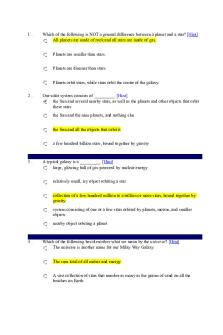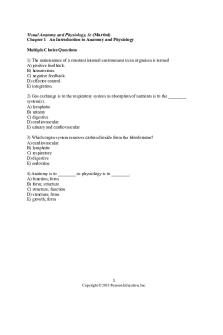Unit 1 absorption questions and answers PDF

| Title | Unit 1 absorption questions and answers |
|---|---|
| Course | Principles of Pharmacology SFW |
| Institution | University of Guelph |
| Pages | 2 |
| File Size | 1.4 MB |
| File Type | |
| Total Downloads | 58 |
| Total Views | 129 |
Summary
Unit 1 absorption questions with answers...
Description
Unit 1: Absorption Example Questions (BIOM*3090) Example 1: Will aspirin, a weakly acidic drug (pKa=3.5), be ionized, or uncharged, if it is in an environment where the pH=3.5? Use the Henderson-hasselbach equation to solve: !"#$#%&$'( 𝑝𝐾𝑎 − 𝑝𝐻 = log 3.5 − 3.5 0 = log 10
!
=
1=
!"!"#$#%&$'( !"#$#%&$'( = log !"#$%&%"'&() !"#$#%&$'( !"#$%&%"'&() !"#$#%&$'(
!"#$%&%"'&() !"#$#%&$'( !"#$%&%"'&()
Therefore, the ratio of protonated to unprotonated aspirin is equal to 1. The drug is 50% ionized and 50% uncharged. Example 2: Will aspirin, a weakly acidic drug (pKa=3.5), be ionized, or uncharged, if it is in the stomach (pH=1.4)? Use the Henderson-hasselbach equation to solve: !"#$#%&$'( 𝑝𝐾𝑎 − 𝑝𝐻 = log 3.5 − 1.4 = log 2.1 = log 10(!.!) =
!"#$%&%"'&() !!"#$#%&$'(
!"#$%&%"'&() !"#$#%&$'( !"#$%&%"'&() !"#$#%&$'( !"#$%&%"'&() !"#!"#$!%&
125.89 =
!"#$%&%"'&()
Because the fraction is greater than 1 (protonated > unprotonated), the drug will exist in the protonated (or uncharged) form in the stomach. We know that the drug accumulates on the side of the membrane where ionization is highest. We also know that uncharged drugs can cross membranes easily. Therefore, since aspirin is uncharged in the stomach, it will freely cross the membrane into the blood and be absorbed systemically. The diagram in the notes can also be used to answer this question. For weak acids (such as aspirin), when the pH < pKa the compound is protonated, or uncharged (AH).
Example 3: Will aspirin, a weakly acidic drug (pKa=3.5), be ionized, or uncharged, if it is in the blood (pH=7.4)? Use the Henderson-hasselbach equation to solve: !"#$#%&$'( 𝑝𝐾𝑎 − 𝑝𝐻 = log !"#$%&%"'&() !"#$#%&$'(
3.5 − 7.4 = log −3.9 = log 10
(!!.!)
=
!"#!"#"$%#&' !"#$#%&$'(
!"#$%&%"'&() !"#$#%&$'(
!"#$%&%"'&() !"#$#%&$'(
0.000126 =
!"#$%&%"'&()
Because the fraction is less than 1 (protonated < unprotonated), the drug will exist in the unprotonated (or charged/ionized) form in the blood. As we know, ionized drugs cannot cross membranes freely and thus aspirin will be trapped in the blood and absorbed systemically. Example 4: Will naproxen, a weakly acidic drug (pKa=5.0), be better absorbed from the stomach (assuming pH=1.4) or from the intestine (assuming pH=6.4)? In the stomach: !"#$#%&$'( 5.0 − 1.4 = log 3.6 = log 10(!.!) = 3981.07 =
!"#$%&%"'&() !"#$#%&$'(
!"#$%&%"'&() !"#$#%&$'( !"#$%&%"'&() !"#$#%&$'( !"#$%&%"'&()
Because the fraction is greated than 1 (protonated > unprotonated), the drug will exist in the protonated (or uncharged) form in the stomach and will readily cross into the bloodstream. In the intestines: 5.0 − 6.4 = log −1.4 = log 10
(!!.!)
=
!"#$#%&$'( !"#$%&%"'&() !"#$#%&$'(
!"#$%&%"'&() !"#$#%&$'(
!"#$%&%"'&() !"#$#%&$'(
0.03981 =
!"#$%&%"'&()
Because the fraction is less than 1 (protonated < unprotonated), the drug will exist in the unprotonated (or charged/ionized) form in the intestines and the majority of the drug will not readily cross into the bloodstream. Thus, naproxen, will be better absorbed from the stomach, where most of the drug is uncharged and can cross freely into the bloodstream to be absorbed systemically....
Similar Free PDFs

Midterm 1, questions and answers
- 8 Pages

1 2020, questions and answers
- 12 Pages

Quiz 1 questions and answers
- 4 Pages

Midterm 1, questions and answers
- 14 Pages

Quiz 1 - questions and answers
- 5 Pages

Exercise 1 Questions and Answers
- 4 Pages

TEST 1, questions and answers
- 30 Pages

Quiz 1 Questions and Answers
- 2 Pages

Week 1 Questions and Answers
- 2 Pages
Popular Institutions
- Tinajero National High School - Annex
- Politeknik Caltex Riau
- Yokohama City University
- SGT University
- University of Al-Qadisiyah
- Divine Word College of Vigan
- Techniek College Rotterdam
- Universidade de Santiago
- Universiti Teknologi MARA Cawangan Johor Kampus Pasir Gudang
- Poltekkes Kemenkes Yogyakarta
- Baguio City National High School
- Colegio san marcos
- preparatoria uno
- Centro de Bachillerato Tecnológico Industrial y de Servicios No. 107
- Dalian Maritime University
- Quang Trung Secondary School
- Colegio Tecnológico en Informática
- Corporación Regional de Educación Superior
- Grupo CEDVA
- Dar Al Uloom University
- Centro de Estudios Preuniversitarios de la Universidad Nacional de Ingeniería
- 上智大学
- Aakash International School, Nuna Majara
- San Felipe Neri Catholic School
- Kang Chiao International School - New Taipei City
- Misamis Occidental National High School
- Institución Educativa Escuela Normal Juan Ladrilleros
- Kolehiyo ng Pantukan
- Batanes State College
- Instituto Continental
- Sekolah Menengah Kejuruan Kesehatan Kaltara (Tarakan)
- Colegio de La Inmaculada Concepcion - Cebu






